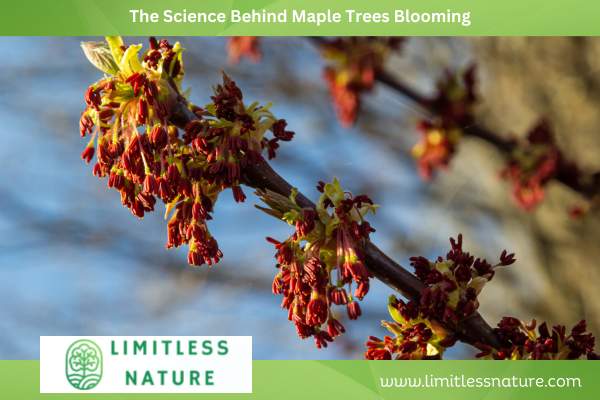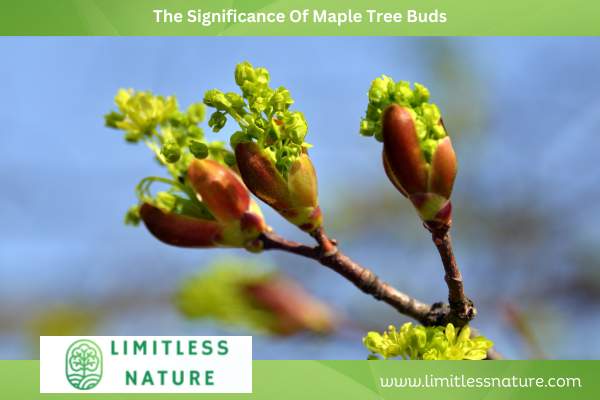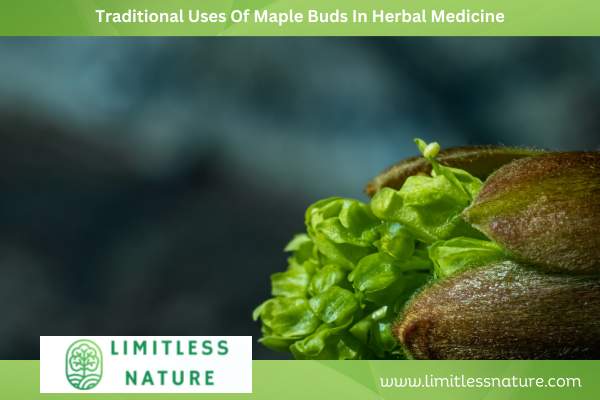Maple trees, popular for their stunning fall foliage, have a specific time when they begin to bud.
The timing of their bloom varies depending on the climate and the specific maple species.
Generally, maple trees start to bud in early spring when the weather becomes milder.
These buds are the initial signs that the tree is coming out of its dormancy period.
The buds on maple trees are of two types: female flowers and male flowers.
The female flowers develop into samaras, which are the winged seeds characteristic of maple trees.
On the other hand, the male flowers produce the pollen necessary for fertilization.
When the maple tree breaks bud, it means that the buds begin to open, revealing tiny leaves and flowers in various shades of green and red.
This process marks the beginning of the tree’s growth and its transition into full foliage.
In this article, we’ll explore the science behind this process and discuss why maple tree buds are significant to humans and wildlife.
The Science Behind Maple Trees Blooming

Let’s dive into the science behind those little pops of green that signal spring has finally arrived!
Maple trees, particularly the silver maple and red maple (Acer rubrum), begin to bud in late winter.
These trees are unique because they can be either male or female, with males producing pollen and females producing seeds.
Maple trees prepare for spring by developing buds, which are small, rounded structures that contain future leaves, flowers, or seeds.
In the case of maple trees, the buds are covered in protective scales that keep the delicate structures safe during the winter months.
As the weather starts to warm up, the buds swell and eventually burst open to reveal leaves or flowers.
In the case of maple trees, the female flowers develop into maple samaras, commonly known as helicopter seeds.
The process of bud development in maple trees has been extensively studied and documented by experts at botanical institutions like the Arnold Arboretum.
They have observed that some maple species, like the common maple, have buds that thrive in a wide range of conditions, making them adaptable to different environments.
Whereas others, like the silver maple, require specific environmental cues to initiate bud development and are more sensitive to changes in their surroundings.
Understanding the science behind maple tree budding helps researchers and arborists cultivate these beautiful trees in their ideal environments and contributes to a greater appreciation of the natural world.
The Significance Of Maple Tree Buds

The significance of maple tree buds lies in their role in the annual reproductive cycle of these trees.
Maple trees are known for their vibrant fall foliage, but their buds are equally important.
There are a variety of maple species, and each has its unique bud characteristics.
In the late winter or early spring, maple tree buds begin to swell as the days lengthen and the weather warms. These buds contain tiny flowers that will eventually develop into seeds.
The female flowers, known as stigmas, capture pollen and initiate pollination.
The male flowers produce pollen, which is then carried by insects or wind to the female flowers.
The sugar content of the sap in these buds allows them to survive freezing temperatures.
In April and June, the buds finally open, revealing the delicate and colorful tiny flowers within.
While some maple species bloom as early as March, others could not bloom until late April or May.
These flowers are often inconspicuous, but they play a vital role in producing the distinct maple seeds that allow for the dispersal and growth of new maple trees.
Environmental Impact
You’ll be amazed by the immense impact that the changing of seasons has on our natural surroundings.
Maple trees, for instance, are a vital part of many ecosystems in North America.
However, climate change adaptation and carbon footprint reduction have become increasingly important topics as we face the consequences of our actions.
As temperatures rise and weather patterns become unpredictable, tree species like maples may struggle to survive.
The environmental impact of maple trees goes beyond their aesthetic value and cultural significance.
They play a crucial role in maintaining healthy soil and air quality, providing shade and habitat for wildlife, and even contributing to local economies through tourism and syrup production.
Understanding how they respond to changing climate conditions is not only important for their survival but also for the well-being of entire ecosystems that rely on them.
So next time you spot a budding maple tree, take a moment to appreciate its resilience and importance to our planet’s health.
Importance To Wildlife
Discover how crucial maple trees are to the survival of many wildlife species in North America, and the important role they play in maintaining healthy ecosystems.
Maple trees provide vital habitats for a wide range of wildlife, including birds, squirrels, chipmunks, and bears.
During the spring season when the sap starts flowing through the tree’s branches, it attracts a host of pollinators such as bees and butterflies that help to fertilize other plants around them.
The leaves on maple trees also provide food for many caterpillars which later become butterflies or moths themselves.
Maple trees are an integral part of seasonal changes in North America as they mark both the beginning of spring with their buds opening up and towards fall when their leaves turn into brilliant shades of reds and yellows.
They serve as natural landmarks for migrating birds who depend on them for shelter and nourishment during long flights across continents.
Without these majestic trees, many wildlife species would not have suitable habitats to live in or enough food sources to sustain themselves throughout different seasons.
As we move onto exploring traditional uses in herbal medicine, let’s remember that these magnificent trees offer much more than just aesthetic beauty.
Traditional Uses Of Maple Buds In Herbal Medicine

Maple buds have been widely used in herbal medicine for centuries due to their numerous beneficial properties.
The buds, also known as “maple flower stalks,” are the small and delicate protuberances found on the branches of the maple tree.
These buds contain essential oils, flavonoids, and antioxidants which contribute to their medicinal value.
Traditionally, the buds were harvested during the early spring when they were filled with the life force of the tree.
Maple buds were commonly used to treat respiratory conditions such as coughs and bronchitis due to their expectorant and anti-inflammatory properties.
In addition, they were also employed to alleviate digestive issues and to promote better blood circulation.
When the flowers and leaves of the maple tree emerge, they catch pollen and cause maple allergies in some individuals.
However, the buds of maple can be used to mitigate these allergic reactions by acting as natural antihistamines.
Overall, the traditional uses of maple buds in herbal medicine highlight their versatile and valuable properties in promoting wellness and providing natural remedies for various ailments.
Frequently Asked Questions
How do you identify the different species of maple trees based on their buds?
To identify different species of maple trees based on their buds, you’ll need to pay close attention to the physical characteristics of the buds themselves.
The size, shape, color, and texture of the bud can all provide important clues as to what type of maple tree you’re dealing with.
For example, red maple buds tend to be small and pointy, while sugar maple buds are larger and rounder.
In terms of bud growth, climate factors like temperature and moisture can play a significant role in shaping the appearance of the buds.
By carefully observing these features and learning about how they vary across different species, you’ll be well on your way to becoming an expert at identifying maple trees by their buds alone.
Can you make syrup from the buds of maple trees?
Did you know that maple tree cultivation goes beyond tapping the trees for their sap? The culinary uses of maple tree buds are often overlooked but can add a unique flavor to your dishes.
While it is possible to make syrup from the buds, it’s not recommended as they contain less sugar than the tree’s sap.
Instead, try using them in marinades, dressings, or even pickling them for a tangy addition to sandwiches and salads.
Before harvesting any buds, be sure you can correctly identify the species of maple tree you’re working with as some may have toxic qualities.
With proper knowledge and care, utilizing maple tree buds can add an unexpected twist to your cooking repertoire.
What factors can affect the timing of maple tree budding?
Ah, the elusive maple tree bud. A truly mysterious creature, indeed. But fear not! With your keen eye and expert knowledge (thanks to this snippet), you can uncover the factors that affect the timing of these buds.
Climate patterns play a crucial role in determining when maple trees will bud – warmer temperatures signal the start of bud development, whilst colder weather can delay it.
Soil conditions also come into play, as moisture levels and nutrient content can impact growth rates.
So, next time you’re out on a nature walk and spot a budding maple tree, impress your friends with your newfound expertise on the subject!
Are there any pests or diseases that can affect maple tree budding?
To ensure healthy budding of maple trees, it’s important to be aware of potential pest and disease threats.
Some common pests that can affect maple trees include aphids, scale insects, and borers. These pests can cause damage to the tree’s bark and leaves, which in turn can impact bud development.
Similarly, diseases such as verticillium wilt or tar spot fungus can also weaken the tree and hinder proper budding.
Preventative measures such as regular monitoring and pruning can help mitigate these issues. Treatment options may include chemical insecticides or fungicides if necessary.
Additionally, climate change has been observed to impact maple tree bud development by altering temperature patterns and causing shifts in growing seasons.
It’s important to stay informed about these changes and adjust management practices accordingly for optimal growth outcomes.
How do maple trees use their buds to survive harsh winter conditions?
During winter, maple trees use their buds to survive harsh conditions. These buds contain protective structures that prevent them from freezing and dying off during the cold months.
In fact, as temperatures drop, the buds undergo a process called bud swelling where they take in water and increase in size. This allows them to better tolerate low temperatures and remain dormant until spring arrives.
Maple trees also have dormancy mechanisms that help them conserve energy during this time by slowing down their metabolic processes.
These mechanisms involve changes in hormone levels and gene expression that are triggered by environmental cues such as temperature and day length.
All of these adaptations help maple trees survive winter and prepare for new growth when warmer weather returns.
Conclusion On When Do Maple Trees Flower Buds
In conclusion, the flowering buds of maple trees typically appear in spring, between the months of March and June.
The exact timing can vary depending on the species and the climate conditions.
Native to North America, maple trees begin blooming in the late spring as their maple leaves begin to unfurl.
Different species of maple can bloom as early as March, while others may flower in late April or May.
For example, the Japanese maple typically blooms earlier than the red maple trees, which in turn bloom earlier than the Norway maple.
The blooming of maple trees is an important event as it marks the beginning of the pollination process, which is crucial for the reproduction of the trees.
Ultimately, the flowering buds of maple trees signal the awakening of nature and the arrival of warmer weather.
